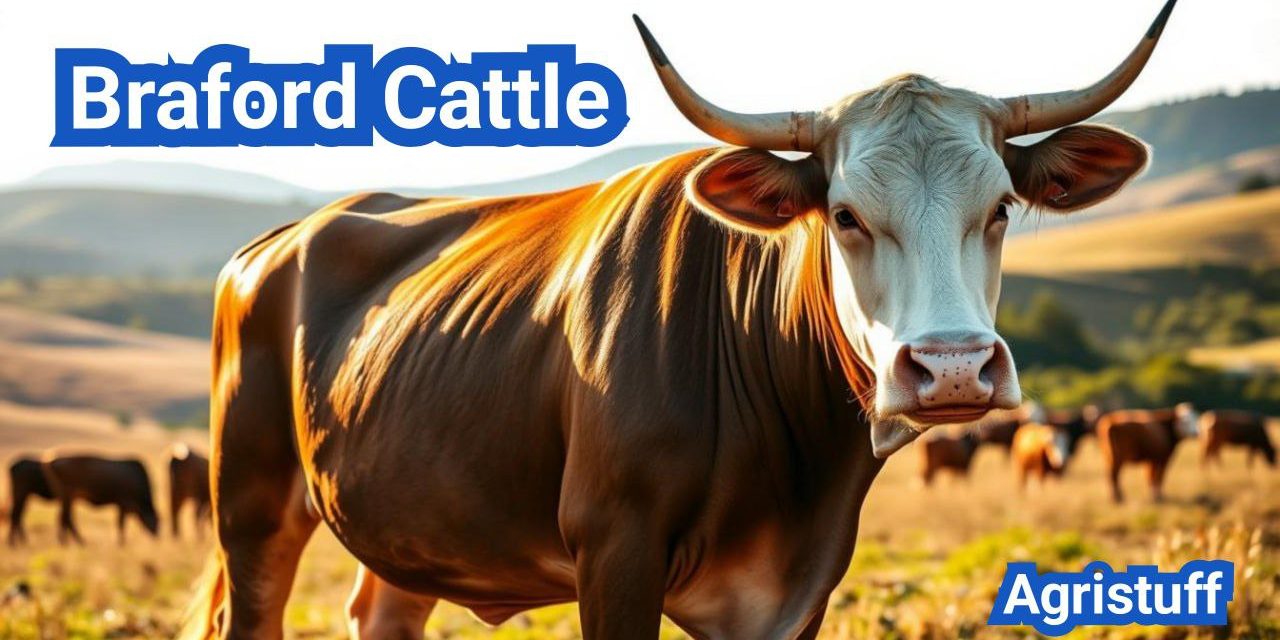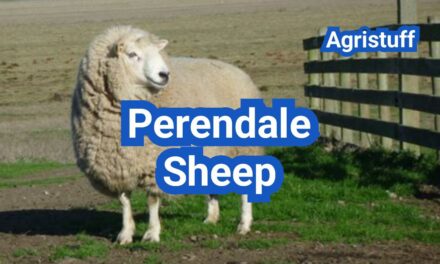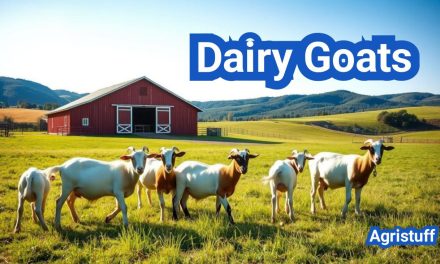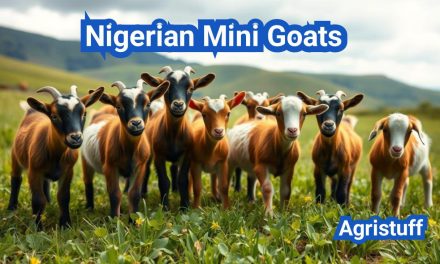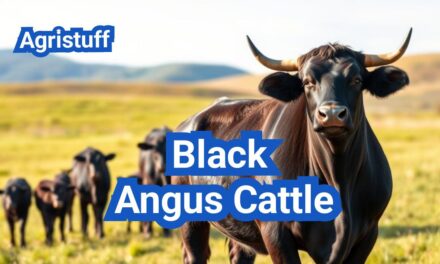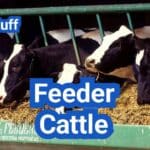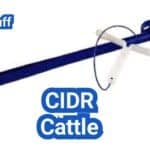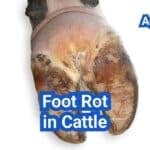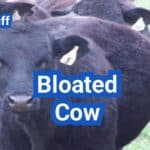The Braford breed ( Braford Cattle ) is a robust hybrid developed for efficient beef production. By crossing Hereford bulls with Brahman cows, farmers created a resilient and adaptable animal well-suited for various livestock farming conditions.
This hybrid breed combines the hardiness of Brahman cows with the desirable traits of Hereford bulls, resulting in a consistent and high-quality product for the beef industry.
Key Takeaways
- The Braford breed is a hybrid of Hereford cattle and Brahman cattle.
- It is known for its hardiness and adaptability in various farming conditions.
- Braford cattle are suitable for efficient beef production.
- The breed combines the desirable traits of both parent breeds.
- It is an important part of modern livestock farming.
The Origin and History of Braford Cattle
With roots tracing back to the 1940s, the Braford breed was developed to create a robust and productive beef cattle breed. The story of Braford cattle begins with the innovative breeding programs that took place in the mid-20th century, primarily in the United States and Australia.
The development of Braford cattle is attributed to the crossbreeding of Brahman and Hereford cattle, aiming to combine the hardiness and heat tolerance of Brahman with the beef quality and temperament of Hereford.
Development of the Brahman-Hereford Cross
The Braford breed was first developed in Florida in 1947 by Alto Adams Jr., who crossed Hereford bulls with Brahman cows. This pioneering effort was aimed at creating a breed that could thrive in challenging environmental conditions while maintaining high beef production standards.
The Brahman-Hereford cross proved to be highly successful, resulting in offspring that were not only resilient to heat and disease but also possessed the desirable beef characteristics of the Hereford breed.
Evolution in Australia and the United States
A separate Braford bloodline was also developed in Australia between 1946 and 1952, further enriching the genetic diversity of the breed. The evolution of Braford cattle in both countries was marked by a careful selection process, focusing on enhancing the breed’s productivity, fertility, and adaptability to different farming conditions.
The parallel development of Braford cattle in the United States and Australia underscores the global interest in creating a superior beef cattle breed. Today, Braford cattle are recognized for their significant contributions to the beef industry, offering a unique combination of hardiness, productivity, and meat quality.
Understanding Braford Cattle Characteristics

With a foundation in both Brahman and Hereford genetics, Braford cattle exhibit superior traits that make them ideal for beef production. Their characteristics are shaped by the strengths of their parent breeds, resulting in a robust and productive cattle breed.
The Brahman and Hereford Foundation
The Braford breed combines the heat tolerance and hardiness of Brahman cattle with the high-quality beef production characteristics of Hereford cattle. This foundation provides Braford cattle with the ability to thrive in various environmental conditions while maintaining excellent growth rates and meat quality.
Genetic Advantages of Hybrid Vigor
One of the key advantages of Braford cattle is the benefit of hybrid vigor, which results from the crossbreeding of two distinct breeds. This genetic diversity leads to improved fertility, faster growth rates, and enhanced overall performance. The hybrid vigor in Braford cattle contributes to their:
- Superior maternal ability
- Early puberty
- High fertility rates
- Ease of calving
These traits make Braford cattle an attractive choice for producers looking to optimize their beef production operations.
Physical Traits and Identification Guide
Identifying Braford Cattle involves understanding their distinct physical characteristics, which set them apart from other cattle breeds. Braford Cattle are known for their robust build and specific color patterns.
Distinctive Appearance and Color Patterns
Braford Cattle typically exhibit a red coat with a white underbelly, head, and feet. This distinctive color pattern is a result of their Brahman and Hereford ancestry. The white coloration on their face, underbelly, and legs is a key identifier.
Key Features:
- Red coat with white underbelly, head, and feet
- Stocky build indicating hybrid vigor
- Distinctive white facial markings
Size and Weight Specifications
Braford Cattle are known for their stocky build, which contributes to their overall size and weight. Males typically weigh between 1,800 to 2,200 pounds, while females weigh between 1,000 to 1,400 pounds.
Size and Weight Ranges:
| Category | Weight Range (lbs) |
|---|---|
| Males | 1,800 – 2,200 |
| Females | 1,000 – 1,400 |
Tiger Stripe and Black Braford Variations
In addition to the typical red and white coloration, Braford Cattle can also exhibit “tiger stripe” patterns or be entirely black. These variations are a result of genetic diversity within the breed.
Tiger Stripe Braford: Characterized by dark striping over a red or white base coat.
Black Braford: Entirely black coat, resulting from specific genetic combinations.
These variations are recognized within the Braford breed and contribute to their overall genetic diversity.
Why Choose Braford Cattle for Beef Production

For producers looking to optimize their beef production, Braford cattle offer a compelling solution with their superior yield and economic benefits.
Braford cattle have gained popularity in the cattle farming industry due to their robust characteristics, which make them particularly suited for beef production. Their hybrid vigor, derived from the Brahman and Hereford breeds, contributes to their superior meat quality and feed efficiency.
Meat Quality and Yield Advantages
Braford cattle are known for producing high-quality beef with desirable marbling, tenderness, and flavor. The breed’s genetic makeup ensures a superior yield, making it an attractive choice for producers aiming to meet the demand for premium beef products.
The meat quality advantages of Braford cattle include:
- Enhanced marbling for tender and flavorful beef
- Improved yield due to efficient growth rates
- Desirable fat distribution for high-quality cuts
Feed Efficiency and Growth Rates
One of the key benefits of Braford cattle is their feed efficiency, which allows them to achieve optimal growth rates while minimizing feed costs. This efficiency is crucial for producers looking to reduce their operational expenses and enhance profitability.
| Breed | Feed Conversion Ratio | Average Daily Gain |
|---|---|---|
| Braford | 6.5 | 1.8 lbs |
| Other Breeds | 7.0 | 1.5 lbs |
Economic Benefits for Producers
The economic benefits of raising Braford cattle are significant. Their hardiness and adaptability reduce the need for costly interventions, while their efficient growth rates and superior meat quality command higher prices in the market.
Producers can benefit from:
- Reduced feed costs due to efficient conversion
- Higher market prices for premium beef products
- Lower veterinary and maintenance costs due to the breed’s hardiness
Assessing Your Farm’s Suitability for Braford Cattle
Assessing your farm’s compatibility with Braford Cattle is essential for a thriving cattle operation. Braford Cattle are known for their heat tolerance and adaptability, but like any cattle breed, they have specific requirements that need to be met for optimal performance.
Climate and Environmental Considerations
Braford Cattle are well-suited to warm climates due to their Brahman heritage, which provides them with a high level of heat tolerance. However, they still require adequate shade and access to clean water to thrive. When assessing your farm’s climate, consider the average temperature, humidity levels, and the availability of shade and water resources.
Key climate considerations include:
- Average temperature and extreme weather conditions
- Humidity levels and their impact on cattle comfort
- Availability of natural shade or the need for shade structures
- Access to clean, reliable water sources
Land Requirements and Carrying Capacity
The suitability of your land for Braford Cattle depends on several factors, including the quality of pasture, land topography, and carrying capacity. Braford Cattle can thrive on a variety of pasture types, but the land needs to be well-managed to maintain productivity.
Land assessment should consider:
- Pasture quality and nutritional value
- Land topography and its impact on grazing and cattle management
- Carrying capacity to avoid overgrazing and ensure sustainable grazing practices
By carefully evaluating these factors, you can determine whether your farm has the potential to support a successful Braford Cattle operation.
How to Select Quality Braford Breeding Stock

To establish a thriving Braford cattle operation, producers must prioritize the selection of superior breeding stock. This involves a comprehensive evaluation of potential breeding animals to ensure they possess the desired traits for optimal production.
Evaluating Bulls and Heifers
When evaluating bulls and heifers for breeding purposes, several key factors come into play. Physical conformation and genetic potential are crucial. Producers should look for animals with a robust build, indicative of good health and vigor.
The reproductive health of both bulls and heifers is paramount. For bulls, a breeding soundness examination is essential to assess fertility. Heifers should be evaluated based on their reproductive tract score, which indicates their potential for early breeding success.
Understanding EPDs and Genetic Markers
Expected Progeny Differences (EPDs) are a valuable tool in selecting Braford breeding stock. EPDs provide an estimate of an animal’s genetic potential for various traits, such as growth rate and milk production. By analyzing EPDs, producers can make informed decisions about which animals to breed.
Genetic markers, on the other hand, offer insights into specific genetic traits that can influence the quality and performance of offspring. For instance, certain genetic markers can indicate resistance to diseases or the potential for improved meat quality.
| Trait | EPD Description | Benefit |
|---|---|---|
| Growth Rate | Estimate of an animal’s genetic potential for growth | Faster maturation, earlier to market |
| Milk Production | Prediction of a dam’s milk production potential | Improved calf weaning weights |
| Disease Resistance | Genetic markers indicating resistance to certain diseases | Reduced veterinary costs, healthier cattle |
Sources for Purchasing Registered Braford Cattle
For producers looking to acquire registered Braford cattle, several reputable sources are available. The United Braford Breeders Association is a primary resource, offering a directory of registered breeders and their cattle.
Additionally, cattle auctions and breed-specific sales events provide opportunities to purchase high-quality Braford breeding stock. Producers should conduct thorough research and due diligence when purchasing from these sources to ensure they are acquiring animals that meet their operation’s needs.
Setting Up Your Braford Cattle Operation

A well-planned Braford Cattle operation is crucial for maximizing efficiency and profitability in cattle farming. To achieve this, it’s essential to focus on the foundational elements that contribute to a successful operation.
Facility Requirements and Design
The design and condition of facilities play a significant role in the overall success of a Braford Cattle operation. Adequate fencing is crucial for maintaining the integrity of the operation and ensuring the safety of both the cattle and the surrounding environment.
When designing facilities, consider the following:
- Durable materials for fencing and enclosures
- Adequate space for cattle movement and grazing
- Proper drainage and water management systems
- Accessibility for feeding, watering, and veterinary care
| Facility Component | Considerations | Benefits |
|---|---|---|
| Fencing | Material durability, height, and design | Prevents escape, predator control, and cattle safety |
| Grazing Areas | Size, pasture quality, and rotational grazing | Optimal nutrition, reduced erosion, and improved cattle health |
| Watering Systems | Cleanliness, accessibility, and water quality | Ensures cattle hydration and health |
Equipment and Resource Needs
In addition to facilities, the right equipment and resources are vital for a Braford Cattle operation. This includes:
- Feeding equipment (e.g., feeders, hay storage)
- Veterinary care supplies and equipment
- Handling equipment (e.g., chutes, sorting facilities)
- Transportation vehicles for cattle
As noted by cattle farming experts, “Investing in quality equipment and resources can significantly impact the efficiency and profitability of a Braford Cattle operation.”
“The right equipment and well-designed facilities are the backbone of any successful cattle operation. They not only improve daily management tasks but also contribute to the overall welfare of the cattle.”
To further illustrate the importance of proper equipment and facilities, consider the following image:
By focusing on both facility requirements and equipment needs, producers can establish a robust foundation for their Braford Cattle operation, setting the stage for long-term success.
Developing a Nutrition Program for Braford Cattle

Developing an effective nutrition plan is essential for maximizing the potential of Braford Cattle. A well-planned nutrition program involves several key components that work together to ensure the health and productivity of the cattle.
Pasture Management Strategies
Effective pasture management is critical for providing Braford Cattle with high-quality forage. This involves implementing rotational grazing practices to maintain pasture health and productivity. By rotating cattle through different pastures, farmers can prevent overgrazing, reduce soil erosion, and promote the regrowth of forage.
Rotational Grazing Benefits:
- Improved forage quality and quantity
- Enhanced soil health through reduced erosion
- Increased biodiversity in pastures
Feed Formulation Guidelines
Feed formulation is a crucial aspect of a nutrition program for Braford Cattle. The goal is to provide a balanced diet that meets the nutritional needs of the cattle at different stages of their life cycle. This involves selecting the right mix of forages, grains, and supplements.
| Nutritional Component | Recommended Level | Importance |
|---|---|---|
| Protein | 12-15% | Essential for growth and muscle development |
| Energy | 2.5-3.0 Mcal/kg | Critical for maintaining body condition and productivity |
| Calcium | 0.6-0.8% | Important for bone health and development |
Seasonal Nutritional Adjustments
Braford Cattle have different nutritional needs at various times of the year due to changes in climate, pasture quality, and stage of production. Adjusting the nutrition program seasonally can help ensure that the cattle receive the nutrients they need.
For example, during the dry season, additional supplementation may be necessary to compensate for the reduced quality and quantity of pasture.
By understanding and implementing these nutritional strategies, farmers can improve the health, productivity, and profitability of their Braford Cattle operation.
Implementing Effective Breeding Strategies

To maximize the potential of Braford Cattle, farmers must implement well-planned breeding strategies. Effective breeding is crucial for enhancing productivity, improving genetic quality, and increasing the overall profitability of a cattle operation.
Crossbreeding Systems for Optimal Results
Crossbreeding is a key component of a successful Braford Cattle breeding program. By crossing Braford cattle with other breeds, farmers can leverage hybrid vigor, resulting in improved growth rates, enhanced disease resistance, and better adaptation to various environmental conditions.
The choice of crossbreeding system depends on several factors, including the farm’s specific production goals, climate, and market demands. Common crossbreeding systems include rotational crossbreeding and terminal crossbreeding, each with its advantages and considerations.
F1 Braford Development and Management
The F1 Braford, resulting from the cross between Brahman and Hereford cattle, is renowned for its robustness and productivity. Managing F1 Brafords effectively involves careful selection of breeding stock, nutritional management, and health care to ensure they reach their full potential.
Key to successful F1 Braford development is a thorough understanding of their genetic makeup and how it influences their performance under different conditions. This knowledge enables farmers to make informed decisions about breeding, feeding, and overall management.
Reproductive Management Techniques
Reproductive management is a critical aspect of a Braford Cattle breeding program. Techniques such as estrus synchronization, artificial insemination (AI), and pregnancy testing are essential tools for improving reproductive efficiency and achieving desired breeding outcomes.
Implementing these techniques requires a good understanding of cattle reproductive physiology and the ability to manage the breeding process effectively. By optimizing reproductive performance, farmers can improve calving rates, reduce calving intervals, and enhance the overall productivity of their herd.
Daily and Seasonal Management Practices
To maximize the potential of Braford Cattle, farmers must implement robust daily and seasonal management practices. Effective management is crucial for maintaining the health, productivity, and overall well-being of the cattle.
Establishing Routine Care Protocols
Establishing routine care protocols is essential for the daily management of Braford Cattle. This includes regular checks on the cattle’s health, ensuring access to clean water and nutritious feed, and maintaining clean living conditions. Routine vaccinations and health checks are vital for preventing disease and detecting any health issues early.
A well-structured routine care protocol might include:
- Daily monitoring of cattle health and behavior
- Regular cleaning of living areas and equipment
- Provision of high-quality feed and clean water
- Implementation of a vaccination schedule
Handling and Behavioral Management
Handling and behavioral management are critical aspects of Braford Cattle management. Proper handling techniques can reduce stress and improve the overall welfare of the cattle. Training handlers in best practices and ensuring that facilities are designed to minimize stress on the animals are key considerations.
Effective handling and behavioral management strategies include:
| Strategy | Description | Benefits |
|---|---|---|
| Low-Stress Handling | Techniques that minimize stress and discomfort for the cattle | Improved animal welfare, reduced injury risk |
| Facility Design | Designing handling facilities to be safe and efficient | Reduced stress, improved handler safety |
| Handler Training | Training handlers in best practices for cattle handling | Improved handling efficiency, reduced stress |
Record Keeping Systems and Technologies
Accurate record keeping is essential for effective Braford Cattle management. Records can include health checks, breeding information, feed consumption, and growth rates. Utilizing digital record keeping systems can enhance accuracy and efficiency, allowing for better decision-making.
Modern technologies, such as electronic identification systems and data analytics tools, can significantly improve record keeping and management practices.
By implementing these daily and seasonal management practices, farmers can improve the health, productivity, and profitability of their Braford Cattle operations.
Health Management and Disease Prevention

Maintaining the health of Braford Cattle requires a comprehensive approach to disease prevention. Effective health management strategies are crucial for ensuring the well-being and productivity of these animals.
Vaccination Schedules and Protocols
Vaccination is a critical component of disease prevention in Braford Cattle. Implementing a well-structured vaccination schedule can significantly reduce the risk of common cattle diseases.
- Core Vaccines: Include vaccinations against viral and bacterial pathogens.
- Non-Core Vaccines: May be recommended based on regional disease prevalence and farm-specific risks.
- Booster Shots: Essential for maintaining immunity over time.
Consulting with a veterinarian to develop a customized vaccination protocol is advisable to ensure it meets the specific needs of your Braford Cattle operation.
Parasite Control Programs
Parasite control is another vital aspect of health management in Braford Cattle. Internal parasites, such as worms, can significantly impact cattle health and productivity.
- Monitoring: Regularly check for signs of parasitic infestation.
- Deworming: Implement strategic deworming programs tailored to your farm’s parasite load.
- Pasture Management: Rotate pastures to reduce parasite loads and improve overall pasture health.
Effective parasite control requires a multi-faceted approach that includes both treatment and management practices.
Common Health Issues and Treatment
Braford Cattle, like other breeds, can be susceptible to various health issues. Being aware of these common problems and knowing how to treat them is essential for maintaining a healthy herd.
- Respiratory Diseases: Often caused by viral or bacterial infections, requiring prompt veterinary care.
- Reproductive Issues: Can impact breeding success and overall herd productivity.
- Nutritional Deficiencies: Ensuring adequate nutrition is critical for preventing deficiencies.
By understanding these common health issues and implementing effective health management strategies, farmers can improve the overall health and productivity of their Braford Cattle.
Sustainable Farming Practices with Braford Cattle

Sustainability in Braford cattle farming is not just a trend, but a necessity for ensuring the health of our planet and future generations. As the world becomes more environmentally conscious, farmers are under increasing pressure to adopt practices that are not only productive but also sustainable.
Rotational Grazing Implementation
Rotational grazing is a key strategy in sustainable Braford cattle farming. This practice involves moving cattle to different grazing areas to allow the land to recover, thereby improving soil health, reducing erosion, and increasing biodiversity.
Implementing rotational grazing requires careful planning, including:
- Dividing pastures into smaller sections
- Monitoring grass health and density
- Moving cattle based on grass growth rates
Water Conservation Strategies
Water conservation is critical in cattle farming, as it not only saves this precious resource but also reduces the environmental impact of farming operations. Strategies for water conservation include:
- Implementing efficient irrigation systems
- Creating water reservoirs to collect rainwater
- Using drought-resistant grass species
Reducing Environmental Impact
Braford cattle farming can have a significant environmental impact if not managed properly. However, by adopting sustainable practices, farmers can reduce their environmental footprint. This includes:
| Practice | Benefit |
|---|---|
| Rotational Grazing | Improves soil health and biodiversity |
| Water Conservation | Reduces water usage and protects this resource |
| Efficient Manure Management | Reduces nutrient runoff and improves water quality |
By embracing these sustainable farming practices, Braford cattle farmers can not only contribute to a healthier environment but also improve the long-term viability of their operations.
Marketing Your Braford Cattle and Beef Products

Marketing Braford Cattle and beef products requires a multifaceted approach that highlights the breed’s unique characteristics and advantages. Effective marketing strategies can help producers differentiate their products in a competitive market.
Developing Your Brand and Market Position
Establishing a strong brand is crucial for Braford Cattle producers. This involves identifying the unique selling points of your cattle, such as their genetic advantages, meat quality, and sustainable production methods. A well-defined brand helps in creating a loyal customer base and can command a premium price for your products.
Key branding elements include:
- Logo and visual identity
- Brand messaging and story
- Product labeling and packaging
- Marketing materials and campaigns
Direct-to-Consumer Sales Approaches
Direct-to-consumer sales offer Braford Cattle producers an opportunity to connect directly with customers, potentially increasing profit margins and building brand loyalty. Strategies include:
- Farmers’ markets and local events
- Online sales platforms and e-commerce
- Community-supported agriculture (CSA) programs
- On-farm sales and tours
Implementing these strategies effectively requires understanding your target market and tailoring your approach to meet their needs and preferences.
Working with Processors and Distributors
For many Braford Cattle producers, working with processors and distributors is a critical component of their marketing strategy. This involves:
- Identifying reliable partners who can meet your quality and quantity requirements
- Negotiating contracts that ensure fair prices and terms
- Ensuring that partners align with your brand values and marketing goals
Building strong relationships with processors and distributors can help ensure that your Braford Cattle and beef products reach a wider market efficiently.
| Marketing Strategy | Description | Potential Benefits |
|---|---|---|
| Branding | Developing a unique identity for your Braford Cattle and beef products | Increased customer loyalty, premium pricing |
| Direct-to-Consumer Sales | Selling products directly to customers through various channels | Higher profit margins, direct customer feedback |
| Working with Processors and Distributors | Partnering with industry professionals to expand market reach | Increased market penetration, reduced logistical burdens |
Joining Braford Cattle Organizations and Networks
Joining Braford Cattle organizations can be a game-changer for producers looking to enhance their breeding programs. By becoming part of a larger community, breeders can access a wealth of knowledge, resources, and support that can significantly impact their operations.
The Braford Cattle community is supported by various organizations that offer valuable resources and networking opportunities. One of the primary benefits of joining these organizations is the ability to connect with other breeders, share best practices, and stay updated on the latest developments in Braford Cattle breeding.
Benefits of United Braford Breeders Association
The United Braford Breeders Association (UBBA) is a key organization for Braford Cattle breeders. By joining the UBBA, producers can benefit from:
- Networking Opportunities: Connect with other breeders, exchange ideas, and build relationships within the industry.
- Breeding Program Support: Access resources and expertise to enhance breeding programs, including genetic evaluation and selection tools.
- Promotional Activities: Participate in promotional events and campaigns that help raise the profile of Braford Cattle.
As noted by the UBBA, “Our mission is to promote and support the Braford breed through education, marketing, and genetic improvement.” This mission is achieved through various programs and activities that benefit breeders.
Regional Associations and Support Groups
In addition to the UBBA, regional associations and support groups play a crucial role in the Braford Cattle community. These organizations provide localized support, resources, and networking opportunities tailored to the specific needs of breeders in different regions.
Regional associations often host events, such as field days and breeders’ meetings, which offer opportunities for breeders to learn from each other and from industry experts. For example, a regional association might organize a field day where members can share knowledge on best practices in pasture management and cattle health.
Educational Resources and Events
Braford Cattle organizations offer a range of educational resources and events designed to support breeders in improving their operations. These include:
- Workshops and Seminars: Hands-on training and educational sessions on topics such as breeding strategies, cattle health, and pasture management.
- Conferences and Annual Meetings: Opportunities to learn from industry experts and network with other breeders.
- Publications and Online Resources: Access to newsletters, research papers, and online forums where breeders can share information and ask questions.
By participating in these educational activities, Braford Cattle breeders can stay up-to-date with the latest advancements in the field and improve their breeding programs.
In conclusion, joining Braford Cattle organizations and networks is a valuable step for producers looking to enhance their breeding programs and connect with the broader Braford community. Through these organizations, breeders can access a wealth of resources, support, and educational opportunities that can help them succeed in the industry.
Troubleshooting Common Challenges in Braford Farming
Successfully managing a Braford cattle operation requires a deep understanding of the common challenges that can arise and how to troubleshoot them. Braford cattle farmers face a variety of issues, including breeding difficulties, extreme weather conditions, and market fluctuations, that demand effective solutions.
Addressing Breeding Difficulties
Breeding difficulties can significantly impact the productivity of a Braford cattle farm. One of the primary challenges is ensuring the genetic diversity of the herd while maintaining the desirable traits of the Braford breed. To address this, farmers can implement a well-planned breeding program that includes selecting high-quality breeding stock and utilizing techniques such as crossbreeding to enhance hybrid vigor.
Utilizing EPDs (Expected Progeny Differences) and genetic markers can help in making informed decisions about breeding. EPDs provide valuable information on the genetic potential of cattle for various traits, allowing breeders to select animals that are likely to produce offspring with desirable characteristics.
Managing in Extreme Weather Conditions
Braford cattle are known for their heat tolerance and hardiness, but extreme weather conditions can still pose significant challenges. Farmers must be prepared to manage their herds through both hot and cold extremes. Providing adequate shelter, ensuring access to plenty of clean water, and adjusting nutritional programs according to the weather are crucial strategies.
During periods of extreme heat, techniques such as providing shade and implementing sprinkler systems can help reduce heat stress. In colder conditions, ensuring that cattle have sufficient nutrition to maintain body condition is vital.
Overcoming Market Fluctuations
Market fluctuations can have a substantial impact on the profitability of a Braford cattle operation. To mitigate these effects, farmers can diversify their marketing strategies. This might include selling directly to consumers, participating in value-added marketing programs, or developing a strong brand identity.
Staying informed about market trends and being prepared to adapt to changes can help farmers navigate market fluctuations. Additionally, joining Braford cattle organizations and networks can provide valuable resources and support in understanding and responding to market dynamics.
Building a Successful Future with Braford Cattle
By understanding the characteristics, benefits, and management requirements of Braford Cattle, producers can build a successful and sustainable Livestock Farming operation. Effective Cattle Breeding strategies and management practices are crucial for optimizing the potential of Braford Cattle.
Braford Cattle offer a unique combination of hardiness and productivity, making them an attractive choice for farmers seeking to improve their Successful Farming outcomes. By leveraging the genetic advantages of this hybrid breed, producers can enhance meat quality, improve feed efficiency, and increase overall profitability.
As the livestock industry continues to evolve, the importance of informed decision-making and adaptive management practices cannot be overstated. By applying the knowledge and insights gained from this article, farmers and producers can navigate the complexities of Braford Cattle farming and achieve long-term success.
FAQ
What is the Braford Cattle breed?
The Braford Cattle breed is a hybrid breed developed from the Brahman and Hereford cattle breeds, known for its heat tolerance, hardiness, and high-quality beef production.
What are the characteristics of Braford Cattle?
Braford Cattle are known for their distinctive appearance, size, weight, and color patterns, as well as their hybrid vigor, which provides advantages in terms of fertility, growth rate, and disease resistance.
What are the benefits of using Braford Cattle for beef production?
Braford Cattle offer several benefits for beef production, including high-quality meat, feed efficiency, and economic advantages, making them a popular choice among cattle producers.
How do I identify Braford Cattle?
Braford Cattle can be identified by their distinctive appearance, including their coat color and pattern, as well as their size and weight, with variations such as tiger stripe and black Braford.
What are the climate and environmental considerations for Braford Cattle farming?
Braford Cattle are well-suited to hot and humid climates, but require adequate land, water, and nutritional resources to thrive, making climate and environmental considerations crucial for successful farming.
How do I select quality Braford breeding stock?
Selecting quality Braford breeding stock involves evaluating bulls and heifers, understanding EPDs and genetic markers, and sourcing registered cattle from reputable breeders to ensure the genetic integrity of your herd.
What are the key elements of a nutrition program for Braford Cattle?
A nutrition program for Braford Cattle should include pasture management, feed formulation, and seasonal nutritional adjustments to ensure optimal nutrition and health.
How do I implement effective breeding strategies for Braford Cattle?
Effective breeding strategies for Braford Cattle involve crossbreeding systems, F1 Braford development, and reproductive management techniques to optimize fertility and productivity.
What are the benefits of sustainable farming practices with Braford Cattle?
Sustainable farming practices with Braford Cattle, such as rotational grazing and water conservation, can help reduce environmental impact while maintaining productivity and profitability.
How do I market my Braford Cattle and beef products?
Marketing Braford Cattle and beef products involves developing a brand and market position, direct-to-consumer sales approaches, and working with processors and distributors to reach target markets.
What are the benefits of joining Braford Cattle organizations and networks?
Joining Braford Cattle organizations and networks, such as the United Braford Breeders Association, can provide access to educational resources, networking opportunities, and breed expertise.
How do I troubleshoot common challenges in Braford farming?
Troubleshooting common challenges in Braford farming involves addressing breeding difficulties, managing in extreme weather conditions, and overcoming market fluctuations through informed decision-making and adaptive management practices.
Braford Cattle: Overview
Braford cattle are a remarkable hybrid breed developed for beef production, combining the resilience of Brahman cattle with the superior meat quality of Herefords. This Brahman-Hereford cross cattle breed thrives in hot climates, making it a top choice for ranchers in the southern United States and other tropical regions. With strong heat tolerance, disease resistance, and excellent maternal traits, Braford beef cattle are a sustainable and profitable option for modern beef farming.
In this article, we’ll explore the history, characteristics, benefits, and best practices for raising Braford cattle, ensuring you have all the information needed to make an informed decision for your herd.
History and Origin of Braford Cattle
The Braford breed originated in the 1940s through crossbreeding Brahman and Hereford cattle in both the United States and Australia. In Florida, rancher Alto Adams Jr. began experimenting with Brahman-Hereford crosses to create cattle that could withstand the state’s humid, parasite-heavy environment while maintaining high beef quality 19.
Meanwhile, Australian breeders developed their own Braford line to combat drought and tick infestations. Today, Braford beef cattle are recognized as a stabilized breed with a genetic makeup of approximately 3/8 Brahman and 5/8 Hereford, though some variations exist 213.
For more details on the breed’s history, visit the American Braford Breeders Association.
Physical Characteristics of Braford Cattle
Braford cattle exhibit a distinctive appearance, blending traits from both parent breeds:
- Color: Red with white markings (similar to Herefords)
- Build: Stockier than Herefords, with a slight hump and loose skin from Brahman influence
- Heat Adaptations: Sweat glands, hooded eyes (resistant to pinkeye), and thick skin for heat tolerance 14
- Size:
- Bulls: 900–1000 kg (2000–2200 lbs)
- Cows: 550–750 kg (1200–1650 lbs) 13
Their heat-resistant traits make them ideal for beef cattle in hot climates, while their moderate frame ensures efficient feed conversion.
For further reading on breed standards, check the Cattle Site’s Braford Profile.
Advantages of Raising Braford Cattle
Braford beef cattle offer numerous benefits for sustainable beef production:
- Heat and Insect Resistance – Their Brahman genetics provide natural resistance to ticks, reducing reliance on chemical treatments 47.
- High Fertility & Calving Ease – Braford cows reach puberty early and have strong maternal instincts, leading to higher calf survival rates 13.
- Drought Tolerance – They perform well on low-quality forage, making them economical in harsh conditions 13.
- Superior Beef Quality – The Hereford influence ensures good marbling and tenderness, appealing to premium beef markets 7.
- Longevity – Braford cows often remain productive for 15–20 years, reducing replacement costs 4.
For insights on sustainable beef production, visit Kansas State University’s Beef Institute.
Braford Cattle Weight and Growth Performance
One of the key strengths of Braford cattle is their efficient growth:
- Birth Weight: 30–36 kg (66–80 lbs) (lower than pure Brahman, reducing calving difficulties)
- Weaning Weight: 200–270 kg (440–600 lbs) at 7 months
- Feedlot Gains: Up to 2 kg (4.4 lbs) per day in optimized conditions 13
Their moderate frame ensures they finish well without excessive fat, making them ideal for grass-fed and grain-finished systems.
For more on cattle growth metrics, see Oklahoma State University’s Breeds of Livestock.
Nutrition and Feeding Strategies for Braford Cattle
While Braford cattle are hardy, proper nutrition maximizes productivity:
- Forage-Based Diets: They thrive on pasture but benefit from protein supplements in dry seasons.
- Feedlot Efficiency: High starch digestion supports rapid weight gain in finishing phases 8.
- Mineral Supplementation: Ensure adequate phosphorus, zinc, and copper for immune health.
Research from PMC’s Animal Bioscience highlights the role of genetics in feed efficiency.
Braford Cattle Farming in the USA
The USA is a major hub for Braford cattle farming, particularly in:
- Florida, Texas, and the Gulf Coast (hot, humid climates)
- Southeastern states (where ticks and heat stress challenge other breeds)
Many ranchers use Braford bulls on Angus or Hereford cows to enhance hybrid vigor while maintaining beef quality.
For regional breeding tips, explore V8 Ranch’s Crossbreeding Guide.
Sustainable Beef Production with Braford Cattle
Brafords contribute to sustainable beef production by:
- Reducing reliance on parasite treatments (lowering chemical use)
- Thriving on low-input grazing systems
- Offering longevity, decreasing herd turnover and environmental impact 10
Learn more about eco-friendly practices at USDA Sustainable Agriculture.
Final Thought
Braford cattle are a versatile, hardy, and profitable choice for beef producers, especially in hot climates. Their Brahman-Hereford cross genetics deliver heat tolerance, disease resistance, and excellent beef quality, making them a sustainable option for modern ranchers. Whether you’re expanding your herd or optimizing beef production, Brafords offer a competitive edge.
For further guidance, consult local Braford breeders or agricultural extensions to tailor their management to your farm’s needs.
Conclusion of: Braford Cattle | Hybrid Breed for Beef Production
Braford cattle are a unique hybrid breed developed specifically for efficient beef production. By crossing Brahman and Hereford cattle, farmers have created a resilient, adaptable breed suited to diverse climates, especially hot and humid environments. In the United States, Braford cattle have gained popularity among ranchers seeking a balance between growth performance, hardiness, and meat quality.
What Are Braford Cattle?
Braford cattle are a composite beef cattle breed, combining 3/8 Brahman and 5/8 Hereford genetics. This mix gives them superior heat tolerance from Brahman cattle and strong beef conformation from Hereford cattle, making them ideal for southern U.S. beef farms.
Historical Origin of Braford Cattle
Braford cattle were first developed in Florida during the 1940s as ranchers sought a breed that could handle hot, humid conditions while maintaining good beef characteristics. The successful blending of Brahman and Hereford genetics led to the formal recognition of the Braford breed.
Physical Characteristics of Braford Cattle
Braford cattle exhibit features from both parent breeds. They usually have a red body with a white face, underbelly, and socks. Brafords are medium to large in size, with bulls weighing between 1,800 to 2,200 pounds and cows around 1,200 to 1,500 pounds.
Growth Rate and Beef Quality
Braford cattle are known for moderate to high growth rates and efficient feed conversion. Their beef quality is marked by good marbling, tenderness, and high yield, making them competitive in premium beef markets.
Heat Tolerance and Environmental Adaptability
Thanks to their Brahman heritage, Braford cattle are highly tolerant of heat, humidity, and parasites. Their skin is thicker and more resistant to insects, while their sweat glands function efficiently to cool their bodies.
Role of Braford Cattle in U.S. Beef Production
In the southern states, particularly Texas and Florida, Braford cattle are widely used in commercial beef operations. Their adaptability allows ranchers to maintain production even in extreme weather conditions.
Economic Benefits of Raising Braford Cattle
Ranchers favor Braford cattle for several economic reasons:
- Lower veterinary costs due to disease resistance
- Efficient pasture utilization
- High weaning weights in calves
- Strong market demand for heat-adapted beef cattle
Feeding and Nutrition Needs
Braford cattle perform best on high-quality pasture supplemented with minerals and protein concentrates. Their Brahman genetics make them more efficient at utilizing lower-quality forage than many European beef breeds.
Health and Veterinary Management
Although resilient, Braford cattle require routine veterinary care, including vaccinations and parasite control. Monitoring for hoof health and reproductive efficiency is also essential.
Breeding and Genetic Improvement in Braford Cattle
Selective breeding programs focus on enhancing carcass traits, fertility, and adaptability. Many ranchers use artificial insemination (AI) to introduce superior genetics into their Braford herds.
Sustainability and Braford Cattle
Braford cattle contribute positively to sustainable farming practices by thriving on marginal pastures and reducing the need for intensive veterinary treatments or feed supplements. Their hybrid vigor supports efficient, eco-friendly beef production.
Pros of Raising Braford Cattle
- High heat and parasite resistance
- Excellent hybrid vigor and adaptability
- Strong mothering instincts in cows
- Reliable beef production across climates
Cons of Raising Braford Cattle
- Less cold-tolerant than purely European breeds
- May exhibit more temperamental behavior due to Brahman influence
- Requires specific breeding management to maintain desirable traits
Finally
Braford cattle stand out as a robust, adaptable beef breed perfect for hot, humid climates like those found in the southern United States. By blending the strengths of Brahman and Hereford cattle, Brafords offer ranchers a practical solution for sustainable, efficient beef production. With smart herd management, they can provide consistent economic returns and contribute positively to environmentally responsible cattle farming.

